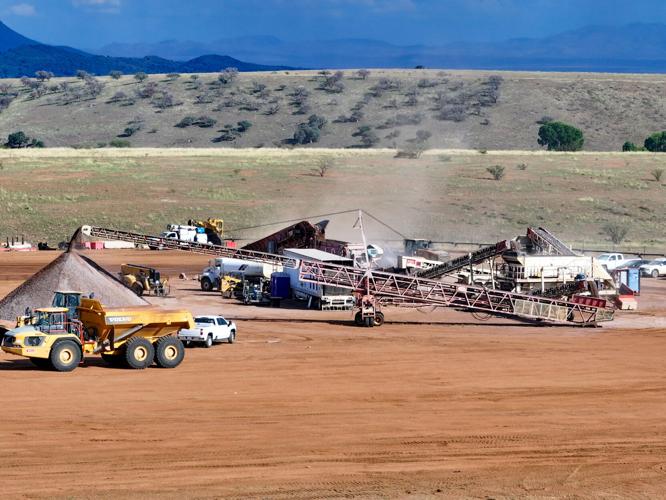Citing the government shutdown, a federal magistrate is postponing action to determine whether the construction of new walls along the southern border by the Department of Homeland Security is illegal.
In a new order Magistrate Judge James Marner acknowledged concerns of environmental groups that delaying the lawsuit while allowing construction to continue ÔÇ£would cause irreversible harmÔÇÖÔÇÖ both to the organizations that sued as well as to several imperiled species that would be affected by the new barrier.
But Marner said he also has to respect the arguments from the Justice Department, which is representing Homeland Security Secretary Kristi Noem, that its lawyers are legally prohibited from working while they are not being paid.

In the San Rafael Valley, near Lochiel, Arizona, a construction crew with Fisher Sand and Gravel uses heavy equipment to grind rocks in preparation for producing concrete on-site. The concrete will fill deep trenches into which workers will sink the steel bollards of the border wall, said Russ McSpadden of the Center for Biological Diversity.
There are exceptions, the magistrate said, including ÔÇ£emergencies involving the safety or human life or the protection of property.ÔÇÖÔÇÖ Absent those conditions, though, federal attorneys are are prohibited from working, ÔÇ£even on a voluntary basis,ÔÇØ he said.
People are also reading…
ÔÇ£This court finds that under the current circumstances in this case, a stay is appropriate,ÔÇÖÔÇÖ he wrote.
Work already has started on a 27-mile stretch through the grasslands of Southern ArizonaÔÇÖs San Rafael Valley. Conservation groups say the 30-foot steel bollards will interfere with the migration of jaguars and other animals.
The federal shutdown is unlikely to slow construction, which is being done not by federal workers but through a $393.5 million contract with Fisher Sand & Gravel Co., unaffected by the lack of a new federal budget.
The lawsuit filed by the Arizona Center for Biological Diversity and CATalyst contends the construction is illegal.
The plaintiffs want a court order to halt the project unless and until it complies with various environmental laws, something that becomes more difficult to do ÔÇö and to undo ÔÇö the more of the wall that is in place.
This may not wind up being the only legal fight with the Trump administration and its desire to build more border walls.

The Trump administration has started construction on 25 miles of 30-foot tall border wall through the grasslands of the San Rafael Valley in Southern Arizona.
On Frday, Homeland Security along with U.S. Customs and Border Protection announced they had awarded 10 contracts totaling $4.5 billion to expand a ÔÇ£Smart WallÔÇÖÔÇÖ system along the southwest border which includes barriers along with patrol roads, lighting, cameras, and detection systems. That list, the agencies said, includes $606 million for 23 miles of new secondary walls in the Tucson sector and another 66 miles of system features in Arizona.
The current lawsuit centers around a provision in the 1996 Immigration Reform and Immigrant Responsibility Act.
It authorizes Homeland Security to construct barriers and roads along the border. The Justice Department says it also allows Noem to waive any legal requirements that she, in her sole discretion, ÔÇ£determines necessary to ensure expeditious construction of the barriers and roads.ÔÇÖÔÇÖ
The lawsuit contends Congress acted illegally in 2005 when it amended the 1996 law, delegating the authority to waive laws to the secretary. Her attorneys dispute that contention.
Russ McSpadden of the Center for Biological Diversity said the delay in court action is unacceptable because of the speed at which construction is continuing.
ÔÇ£A few weeks ago, they had gotten about 350 feet up,ÔÇÖÔÇÖ he said. ÔÇ£And then they hadnÔÇÖt done anything for a few weeks.ÔÇÖÔÇÖ
And now, ÔÇ£TheyÔÇÖve tripled that,ÔÇÖÔÇÖ McSpadden said. ÔÇ£So theyÔÇÖre full steam ahead now.ÔÇÖÔÇÖ
He said that endangers ÔÇ£one of the last, best wildlife corridors in the heart of the sky island ecosystem,ÔÇÖÔÇÖ the valley bordered by the Patagonia and Huachuca mountains on the north and stretching far into Sonora.
ÔÇ£This is truly one of the best jaguar movement corridors we have remaining in the United States,ÔÇÖÔÇÖ McSpadden said, saying three jaguars have used this corridor ÔÇö and gone through where the fence is to be located ÔÇö since 2015.
ÔÇ£Pronghorn also roam in this valley,ÔÇÖÔÇÖ McSpadden said. ÔÇ£Few people know this, but porcupines live in this valley, bears cross here, mountain lions, coatimundi, javelina, you name it, this is one of the most spectacular wildlife corridors left.ÔÇÖÔÇÖ
It isnÔÇÖt clear whether the magistrateÔÇÖs delay necessarily means the case will sit idle, and wall construction will continue, no matter how long it takes for Congress to come up with a plan to fund the government and allow NoemÔÇÖs lawyers to go back to work.
Marner noted that the government asked for ÔÇö and he is granting ÔÇö a stay only ÔÇ£until Department of Justice attorneys are permitted to resume their usual civil litigation functions.ÔÇÖÔÇÖ If the government is still shut down at the end of the month, NoemÔÇÖs attorneys must file a motion to keep the case on hold, he said.
Marner did not say whether he would grant a further stay at that time. McSpadden said that gives challengers a chance to once again present their arguments, though not necessarily to put the case back on the active calendar.
ÔÇ£WeÔÇÖll argue pretty hard that if the case is stayed, then the wall needs to be stayed as well,ÔÇÖÔÇÖ he said.
ÔÇ£We need to put all of this on pause,ÔÇÖÔÇÖ McSpadden said. ÔÇ£ThereÔÇÖs no reason that they should be able to get away with this, holding up our legal case while they just build full steam ahead.ÔÇÖÔÇÖ
Howard Fischer is a veteran journalist who has been reporting since 1970 and covering state politics and the Legislature since 1982. Follow him on X, formerly known as Twitter, , and Threads at @azcapmedia or email azcapmedia@gmail.com.












